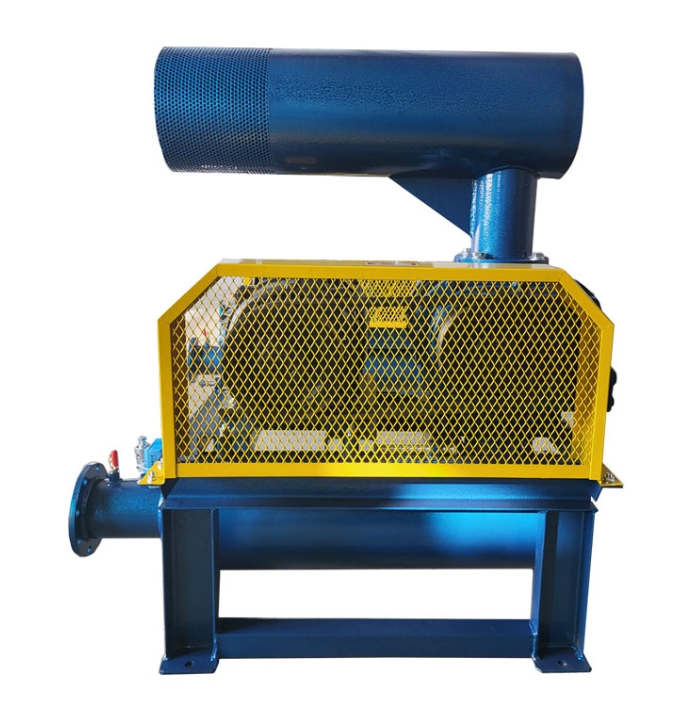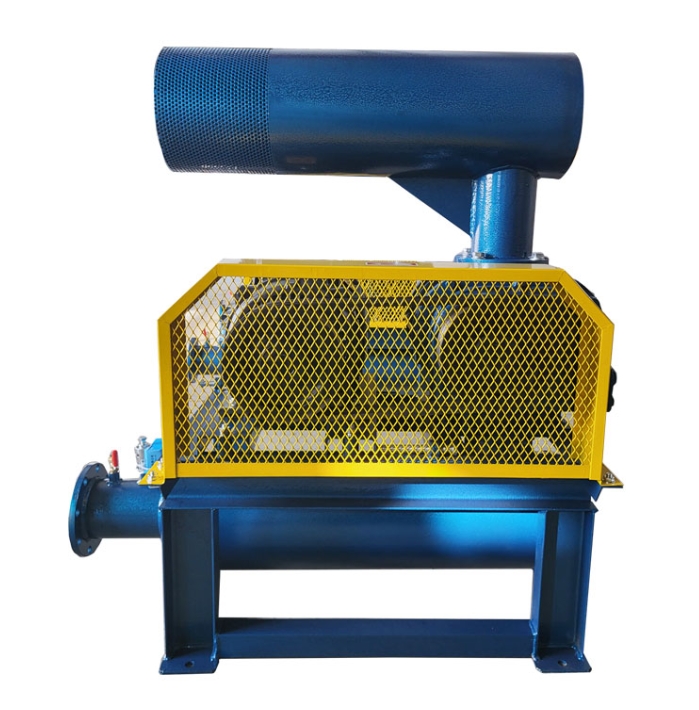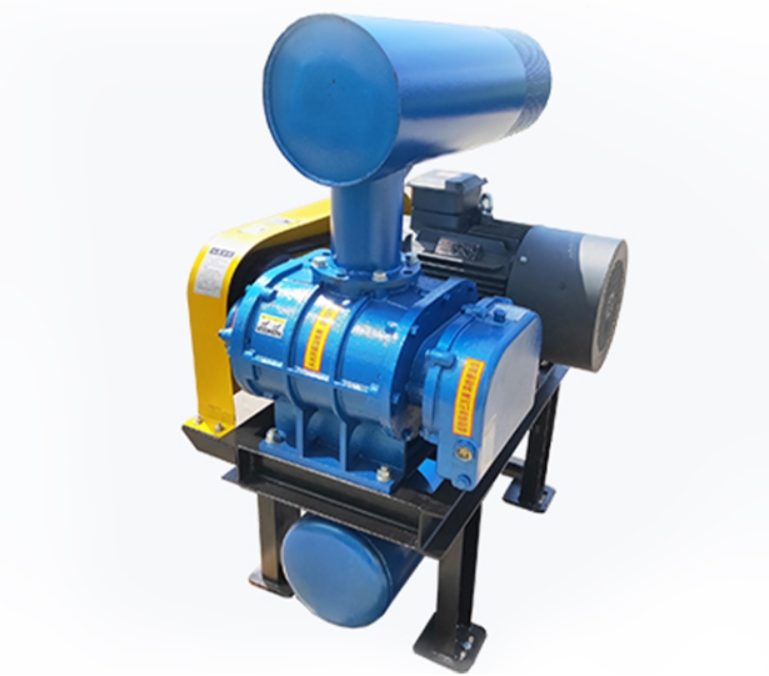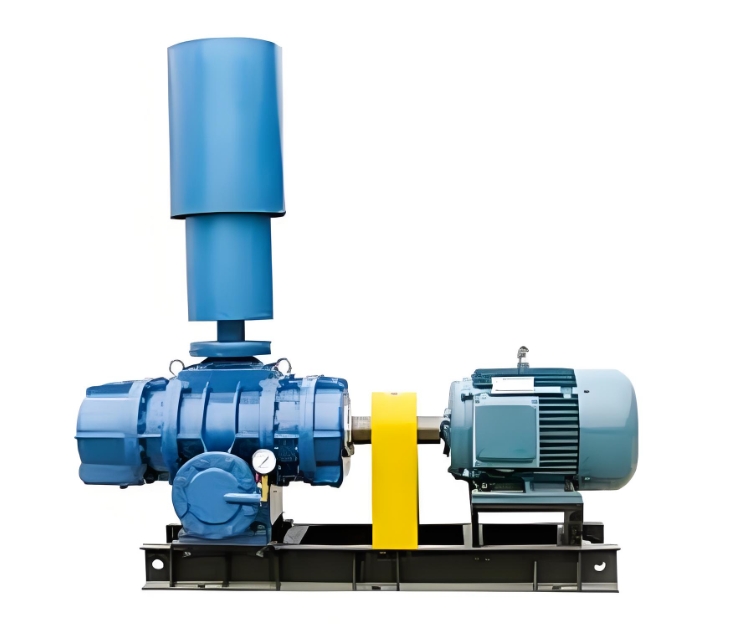**Detailed explanation of the working principle of rotary Roots blower**
Roots blower is a type of positive displacement rotary fan that uses two interlocked rotors to rotate within a cylinder, achieving forced gas delivery. Its core features are * * no internal compression * *, * * constant flow rate * *, suitable for low-pressure, high flow gas transportation scenarios.
---

**1、 Basic structure**
The Roots blower is mainly composed of the following components:
1. * * Rotor (impeller) * *: Usually in the form of 2 or 3 blades, with a shape similar to "∞" or "clover", and mostly made of cast iron or stainless steel.
2. * * Cylinder (casing) * *: accommodates the rotor, forming a closed working chamber.
3. * * Synchronous gear * *: Ensure that the two rotors remain engaged and avoid contact friction.
4. * * Bearings and Seals * *: Support the rotor shaft to prevent gas leakage.
5. * * Inlet and outlet * *: Channels for gas flow.
---
**2、 Working principle**
**1. Gas inhalation stage**
-When the rotor rotates, the volume of the air chamber on the inlet side gradually increases, forming a local vacuum, and external gas is sucked in.
-Key point: The Roots blower itself does not generate suction, but passively inhales gas through volume changes.
**2. Gas enclosed transportation**
-The rotor continues to rotate, enclosing the gas in the chamber formed by the rotor and the cylinder, and pushing it along the inner wall of the cylinder towards the exhaust port.
-* * Non compression characteristics * *: During the transportation process, the gas volume remains unchanged and the pressure does not increase (the pressure is determined by the resistance of the backend system).
**3. Forced gas discharge**
-When the rotor rotates to the exhaust port, the volume of the chamber decreases and the gas is forced out (due to the high pressure on the exhaust side, the gas is "pushed" out).
-Pulsating flow: Due to the periodic engagement of the rotor, there is pulsation in the exhaust airflow (which can be alleviated by a muffler or two-stage design).
---
**3、 Dynamic Process Diagram**
```
Air inlet → | rotor A | rotor B | → exhaust outlet
(Formation of air chamber movement during rotation)
```
-Arrow direction: Gas flow path.
-* * Rotor phase * *: The two rotors always maintain a phase difference of 180 ° (two blades) or 120 ° (three blades) to avoid direct collision.
---
**4、 Core Features**
|* * Features * * | * * Explanation * *|
|-------------------------|--------------------------------------------------------------------------|
|* * No internal compression * * | Gas pressure is generated by system resistance, and the fan itself only delivers gas|
|* * Constant flow rate * * | When the speed remains constant, the flow rate is basically not affected by pressure changes (suitable for scenarios that require stable flow rate)|
|* * Simple structure * * | No complex components such as valves or pistons, easy to maintain|
|* * Stain resistant * * | Can transport dusty and humid gases (requires filter)|
|* * High noise * * | High frequency noise caused by rotor engagement and airflow pulsation (requires muffler)|
---
**5、 Difference from two-stage Roots blower**
-Single stage Roots blower: The gas is transported once and the outlet pressure is relatively low (usually ≤ 0.5 bar).
-Double stage series Roots blower:
-After being pressurized, the gas enters the second stage and is transported again, with a pressure of up to 0.8-1.0 bar.
-A cooler needs to be added in the middle to cool down and prevent gas from overheating.
---
**6、 Typical application scenarios**
1. * * Sewage treatment * *: Aeration tank oxygen supply (constant flow rate is key).
2. * * Pneumatic conveying * *: Pipeline conveying of granular materials (such as cement and flour).
3. * * Vacuum system * *: When used in reverse, it can be used as a vacuum pump (such as a vacuum packaging machine).
4. * * Chemical process * *: Transporting flammable and corrosive gases (requiring explosion-proof/anti-corrosion design).
---
**7、 Frequently Asked Questions and Answers**
**1. Why is the noise of Roots blower loud**
-Mainly caused by the airflow pulsation and mechanical vibration during rotor meshing, it can be reduced through the following methods:
-Choose a three bladed rotor (smoother than a two bladed rotor).
-Install a muffler or soundproof cover.
**2. How to regulate traffic**
-* * Effective method * *: Change the speed (adjust the motor speed through a frequency converter).
-* * Prohibit * *: Regulating through valve throttling (which may cause overpressure and damage to the fan).
**3. What would happen if there was a reversal**
-The rotor may be damaged by collision, and it is necessary to ensure that the steering is consistent with the arrow marked on the housing!
---
**8、 Maintenance points**
1. * * Regular inspection * *: Gear oil level, bearing temperature, rotor clearance.
2. * * Filter cleaning * *: Blockage of the intake filter can cause a decrease in flow rate.
3. * * Avoid overpressure * *: Install valves to prevent excessive system resistance.
---
Mastering the working principle of Roots blower is helpful for correct selection, operation, and fault diagnosis. If you need specific technical parameters or selection suggestions for a particular model, you can provide further analysis of the operating requirements!





